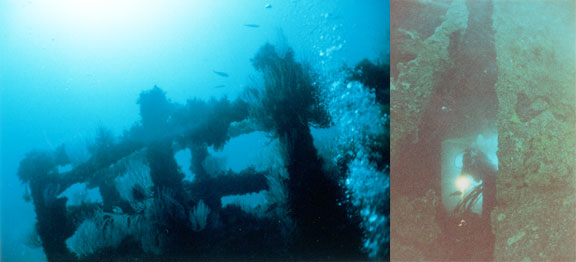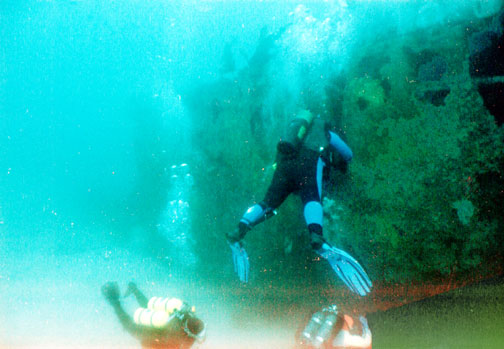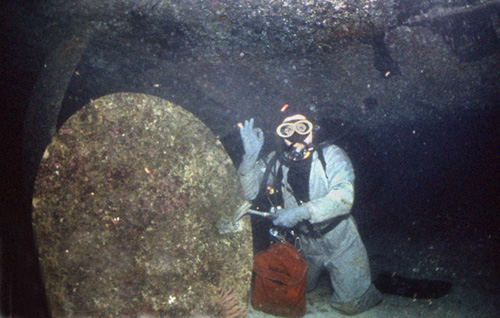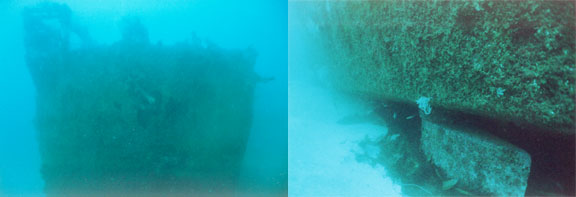John C. Butler (DE-339) is a boat accessible salt water dive site, located in San Clemente Island, CA. This dive site has an average rating of 5.00 out of 5 from 1 scuba divers. The maximum depth is 71-80ft/22-24m. The average visibility is 41-50ft/12-15m.
It is not an exaggeration to call the Butler one of history’s most valiant fighting ships. Just a list of the battles she engaged in is a who’s who of W.W.II sea action. Palau, Morotai, Peliliu, Leyete gulf, Luzon, Iwo Jima, and Okinawa. At Leyete the Butler, with 12 other ships in fleet "Taffy III" were able to locate the center group of a Japanese fleet on course to annihilate the allied transport ships of the Philippine invasion force. The enemy force consisted of 22 ships, including the Yamato, the largest battleship ever built. Into this maelstrom, the Butler and her sisters carried the attack to the enemy. Firing her two 5-inch guns and launching torpedoes while dodging 18-inch shells weighing up to nearly 2 tons apiece, she broke off only when her ammunition was depleted. Returning to the carriers she laid smoke. After 2 hours of battle Admiral Sprague, the commander of Taffy III, heard his signalman curse, "damn it boys, they’re getting away"! Sure enough, unbelievably the Japanese force had had enough and were in retreat. Next came support of amphibious transports invading Luzon. Later in the South China Sea she shot down several attacking Kamikazes. She screened carriers at Lingayen Gulf, protecting ground forces. At Iwo Jima, she supported the invasion force by staving off fierce air attacks yet again. Okinawa was the last major battle that the Butler supported in W.W. II. She rescued downed pilots and even ferried material and men, all the while fending off Japanese suicide bombers. During picket duty after the invasion, on a single evening as the sun was about to set, six Kamikazes bored in out of the sun. Five were shot down by the now well-practiced gunners of the Butler. The masts and antennas were the only thing damaged by the one plane that breached the fusillade of 20mm lead. After repairs, she spent the rest of the war on convoy duty. Incredibly, her W.W.II battle career lasted less than a year. She was decommissioned June 26th 1946 and recommissioned on December 27th 1950, to serve in the Korean conflict. She later served as a training ship until her final decommissioning on December 18th 1957.
For all her gallant actions, the Butler received five battle stars and the Presidential Unit Citation. After all that her fate was to be stricken from the Navy Register on June 1, 1970. Anchored in Northwest Harbor, San Clemente and used as a target for gunnery practice, she sank in December 1971. Even after she sank, she was used for demolition training.
Whenever I dive the broken wreck of the John C. Butler, I pause a moment on the tranquil sand and think of the bravery of some of the finest men who ever served the United States. First is the ship’s namesake, John Clarence Butler. He was only 21 when he made the ultimate sacrifice at the battle of Midway From the carrier Yorktown, through fierce enemy opposition Ensign Butler’s bombing squadron was able to sink three enemy carriers, saving countless numbers of soldiers and sailors.
That is what I think about as I settle softly to the bottom a few yards away and spend just a moment looking and remembering. As the cold clear water lightly surges. I adjust my buoyancy and swim carefully into the wreck and begin to explore... but I never forget.
Diving the Butler 
Left: Depth Charge Racks; Right: Diver looks through the wreckage.
Even though the Butler sits upright, something about the proportions appear confusing at first. Of her original 306’ only about 60’ remain as her bow was blown off and sunk in deep water. Some 50 yards astern of the wreck are the remains of a five-inch gun and about 50’ off her starboard side is the wreck of small scow barge. This dive is rated at an intermediate skill level, but can jump to expert level on the days when surge and reduced visibility can create a potentially dangerous encounter with some of the wreck’s jagged metal. The wreck can be penetrated about 25’, but it is strongly recommended that it be attempted only by divers trained in overhead diving conditions.

Divers explore the Butler’s port quarter.
Although this wreck has been dove for years, there is no telling what you might see as the structure slowly disintegrates. One lucky diver even saw a ship’s compass floating on the overhead ceiling, still in the box (although it has since floated off). There have been rumors about the salvage of the Bulter’s propellers, but the shafts, struts, props, and rudders remain intact, the sand having buried all but the very tops of the bronze blades.
 Bill Wilson knocks growth off the one of the Butler’s bronze props, now buried under the sand.
Bill Wilson knocks growth off the one of the Butler’s bronze props, now buried under the sand. 
Left; the stern of the Butlernote the depth charge rack on the port side; Right: the Butler’s port rudder.
The Butler rests in tropical-like white sand that reflects a fair amount of light, making the wreck site an ideal photo opportunity. Diving on the wreck’s perimeter can be a great place to shoot wide shots of the depth charge racks or fan tail area. Also, the marine life living on the hull also makes the wreck an ideal subject for macro photography.
http://www.cawreckdivers.org/Wrecks/Butler.htm
Bibliography:
Shipwrecks of Southern California 1989 by Cardonne and Smith, Menasha Ridge Press
Guide to Shipwreck Diving, Southern California 1990 by Darren Douglass, Pisces Books
Dictionary of American Naval Fighting Ships Vol. III 1968, Naval History Division